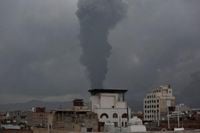On September 4, 2025, a commercial vessel sailing in the Red Sea, northwest of Hudaydah, Yemen, became the latest target in a string of suspected attacks attributed to Yemen’s Houthi rebels. According to the United Kingdom Maritime Trade Operations (UKMTO), the ship’s master reported that an “unknown projectile” landed in the water some distance from the vessel, while the crew experienced intense electronic interference during their transit. Thankfully, both the ship and its crew emerged unharmed, but the incident has stirred fresh anxieties in a region already fraught with maritime danger.
This latest suspected attack is part of a broader escalation in Houthi operations targeting shipping lanes in the Red Sea, a critical artery for global trade. The private security company Ambrey and EOS Risk Group both confirmed the incident, with EOS analyst Martin Kelly observing, “The current tempo reflects a clear escalation, shifting from sporadic launches to multiple daily attempts.” That’s a worrying trend for anyone with a stake in the safety of international shipping.
The Red Sea’s shipping lanes have been under near-constant threat since November 2023, when the Houthis began targeting vessels with missiles and drones in response to the Israel-Hamas war in Gaza. According to the Associated Press, more than 100 ships have been attacked between November 2023 and December 2024, resulting in the sinking of four vessels and at least eight mariner deaths. The rebels’ tactics have grown increasingly sophisticated—and dangerous. In their recent attacks, the Houthis have reportedly used cluster munitions, which break apart into smaller explosives mid-flight. These are especially difficult for defense systems to intercept, raising the odds that some will slip through and cause real damage.
The September 4 incident wasn’t an isolated one. Just a day earlier, on September 3, the Liberian-registered chemical tanker Scarlet Ray, operated by Eastern Pacific Shipping, reported a missile splashing into the sea nearby. The Houthis claimed responsibility, asserting that they had struck the vessel, but the company later confirmed that the Scarlet Ray had not sustained any damage. On September 2, the Houthis also claimed to have hit the containership MSC Aby with two drones and a missile in the northern Red Sea. However, security consultants dismissed that report as likely false, and the vessel’s schedule showed it was due to call at Jeddah, Saudi Arabia, without incident.
Still, the frequency of these attacks is cause for alarm. UKMTO issued warning 030-25 following the September 4 incident, advising ships to exercise extreme caution in the region. The warning comes as Lloyd’s List reports that vessel traffic in the Red Sea actually rose in August to its highest level since January 2024, driven largely by LPG carriers, bulkers, and tankers. Container lines, however, continue to reroute ships around Africa to avoid the mounting threat.
The timing of this escalation is no coincidence. The September 4 attack came just days after an Israeli airstrike killed the Houthis’ self-declared prime minister, Ahmed al-Rahawi, along with several other officials. According to the Associated Press, this strike has fueled a new wave of Houthi aggression, with the group launching multiple missile attacks targeting Israel and shipping interests in the region. The Houthis have not always claimed responsibility for each incident immediately—sometimes waiting hours or even days—but their fingerprints are all over this renewed campaign.
In July 2025, the group’s attacks reached a particularly deadly peak. Two bulk carriers, Magic Seas and Eternity C, were sunk, killing at least four crew members. Some survivors are believed to be held by the rebels, adding a grim human dimension to the risks faced by mariners in these waters. After the July attacks, activity slowed somewhat, but the latest incidents suggest the Houthis are once again ramping up their operations.
The broader political context only adds to the volatility. The Houthis, backed by Iran, initially paused their attacks during a brief ceasefire in the Israel-Hamas war. However, they resumed hostilities after a fierce campaign of U.S.-ordered airstrikes. Former President Donald Trump declared a ceasefire had been reached with the rebels, but the lull proved temporary. Now, as prospects for a new ceasefire in the Israel-Hamas conflict hang in the balance, the Red Sea remains a flashpoint.
Meanwhile, the future of talks between the U.S. and Iran over Tehran’s nuclear program has grown increasingly uncertain. The situation deteriorated further after Israel launched a 12-day war against Iran, during which the U.S. bombed three Iranian atomic sites. This tangled web of regional hostilities, proxy conflicts, and great-power rivalries has made the Red Sea one of the world’s most dangerous maritime corridors.
For shipping companies, the challenge is both immediate and ongoing. The UKMTO’s latest warning underscores the need for heightened vigilance. “We urge all vessels to remain alert and report any suspicious activity,” the agency advised. Private security firms echo this sentiment, noting that the tempo of attacks is not only up, but that the nature of the threats—missiles, drones, and electronic warfare—demands constant adaptation.
It’s not just the shipping industry that’s feeling the heat. The attacks have global economic implications, given the Red Sea’s role as a conduit for oil, gas, and consumer goods. Disruptions here ripple outward, affecting prices and supply chains far beyond the region. Some shipping lines have already opted for longer, costlier routes around the Cape of Good Hope—a move that adds time, expense, and complexity to global logistics.
Despite these challenges, traffic in the Red Sea has not ground to a halt. Lloyd’s List notes that August saw an uptick in vessel movements, with LPG carriers, bulkers, and tankers leading the way. Yet the specter of further attacks looms large, especially as the Houthis show no signs of backing down. “The group is active again,” one security consultant told Marine Insight, “and the risks are real.”
As the world watches for signs of a diplomatic breakthrough in the Israel-Hamas war and the U.S.-Iran nuclear talks, those who make their living on the sea are left navigating a perilous, unpredictable landscape. For now, the only certainty is uncertainty itself—a reality that seafarers, shipping companies, and global markets will have to contend with for the foreseeable future.





